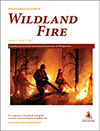
International Journal of Wildland Fire
Volume 31 Number 5 2022
The effect of fuel complex characteristics on wildfire rates of spread appears to be non-existent in the upper end of the fire danger spectrum based on an examination of the pertinent literature. The implications of this conclusion on fire spread modelling and fuels management are discussed.
WF21171 Abstract | WF21171 Full Text | WF21171PDF (1.4 MB) Open Access Article
Models of fuel reduction spatial optimisation commonly assume a dominant regional wind direction. We re-examine this assumption both directly, using a global wildfire dataset, and indirectly, analysing the variance of wind directions during fire weather. In both analyses we find high circular variances in most regions around the globe.
WF21120Interaction between two parallel fire fronts under different wind conditions
 , Luís Reis, Jorge Raposo, André Rodrigues, Domingos Xavier Viegas and Jason Sharples
, Luís Reis, Jorge Raposo, André Rodrigues, Domingos Xavier Viegas and Jason Sharples
The interaction of two parallel fire lines under wind flow conditions in laboratory experiments was studied. The results showed that the interaction has the same tendency independently of the initial distance between the fire lines and that there is a characteristic flow velocity for which the ROS reaches a minimum.
WF21120 Abstract | WF21120 Full Text | WF21120PDF (3.3 MB) Open Access Article
WF21137An analysis of fatalities from forest fires in China, 1951–2018
Fatalities decreased significantly after the establishment of fire management systems. Annual fatalities had a strong positive correlation with number of fires. Fatalities mainly occurred in south and east regions of China with high population densities. Most fatalities occurred in fires with sizes less than 100 ha. Coniferous forest types and 5.1–15° slopes are the main factors related to fatalities.
WF21137 Abstract | WF21137 Full Text | WF21137PDF (3.6 MB) Open Access Article
This paper presents a comparison of prototypes fire shelters, using heat-blocking and insulating layers, with the current USA fire shelter. Field tests supported laboratory comparisons, but proved to be statistically inconclusive in differentiating shelter performance because of the variability inherent in thermal data obtained in field burns.
WF21102 Abstract | WF21102 Full Text | WF21102PDF (5.3 MB) Open Access Article
The concept of co-management has grown in popularity within the wildland fire community but what does co-management really mean in the context of a jurisdictionally complex wildfire? Findings from this study reveal that jurisdictional leaders think differently about co-management. We present a framework for differentiating the disparate mental models of co-management that jurisdictional leaders may encounter, and may need to reconcile, during a wildfire.
WF21139 Abstract | WF21139 Full Text | WF21139PDF (1.6 MB) Open Access Article
WF21089Signs of resilience in resprouting Eucalyptus forests, but areas of concern: 1 year of post-fire recovery from Australia’s Black Summer of 2019–2020
This study presents an early whole-of-landscape assessment of the post-fire recovery trends following Australia’s unprecedented wildfire season of 2019–2020. Early assessment is critical to identify areas of compromised ecosystem resilience. Our assessment demonstrates the effectiveness of remote sensing for broad-scale post-fire recovery assessment. The results have highlighted several regions of concern that require closer examination and identified further research questions for urgent prioritisation as part of adaptive land management programs.



